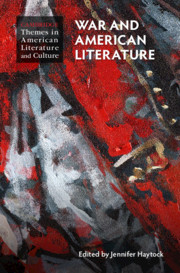Book contents
- War and American Literature
- Cambridge Themes in American Literature and Culture
- War and American Literature
- Copyright page
- Contents
- Contributors
- Acknowledgments
- Chronology
- Introduction
- Part I Aspects of War in American Literature
- Part II Cultural Moments and the American Literary Imagination
- Part III New Lines of Inquiry
- Chapter 18 War and Queerness
- Chapter 19 War and Disability Studies
- Chapter 20 War and Ecocriticism
- Chapter 21 War and Whiteness
- Chapter 22 War and Posthumanism
- Further Reading
- Index
Chapter 19 - War and Disability Studies
from Part III - New Lines of Inquiry
Published online by Cambridge University Press: 20 January 2021
- War and American Literature
- Cambridge Themes in American Literature and Culture
- War and American Literature
- Copyright page
- Contents
- Contributors
- Acknowledgments
- Chronology
- Introduction
- Part I Aspects of War in American Literature
- Part II Cultural Moments and the American Literary Imagination
- Part III New Lines of Inquiry
- Chapter 18 War and Queerness
- Chapter 19 War and Disability Studies
- Chapter 20 War and Ecocriticism
- Chapter 21 War and Whiteness
- Chapter 22 War and Posthumanism
- Further Reading
- Index
Summary
While wartime literature and popular culture frequently casts US soldiers as icons of fitness, few return from combat physically or mentally unscathed. This essay explores the cultural history of American warfare through the lens of disability studies (DS). Framed as a series of test cases, this essay shows how American culture (novels, poetry, film) both highlights and masks the experiences of disabled combatants, during wartime and after. Writers, filmmakers, and others have used tropes of disability to criticize American society and foreign policy. This essay highlights related topics, from the use of disability in wartime propaganda to the ways American culture fosters a hierarchical understanding of disability – celebrating some types of injury (e.g., physical wounds) while denigrating others (e.g., mental injuries). A DS approach allows us to see war in a new way – less as a singular event and more as a series of interwoven processes that affect combatants long after ceasefire.
- Type
- Chapter
- Information
- War and American Literature , pp. 286 - 300Publisher: Cambridge University PressPrint publication year: 2021

